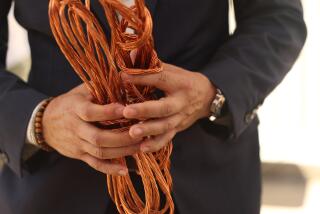Heads, It’s a 1796 Dollar; Tails, It’s a Skid Row Slug
- Share via
It wasn’t exactly the kind of transaction a police officer walking the beat on skid row is used to seeing.
Patrolling 5th Street on Sunday afternoon, Los Angeles police Capt. Andrew Smith noticed two men on the sidewalk selling small, shiny items.
For $20 each, the men were offering 24 silver dollars from the 18th, 19th and early 20th centuries -- some bearing dates that would make them nearly as old as Los Angeles itself.
Smith confiscated the coins and soon learned that this was the fourth time police had come across such a cache.
The coins’ authenticity has yet to be confirmed and their origin remains uncertain. But the novel investigation sparked an unusual level of intrigue for officers who usually deal with such mundane items on skid row as counterfeit DVDs and T-shirt rip-offs.
Authorities said the coins appear to be genuine, but they planned to bring in an expert.
“These coins looked real and authentic. They were old and worn” and probably brought to skid row from someone desperate for drugs, Smith said.
In August, detectives found several such coins inside the jacket lining of a suspected drug dealer arrested on skid row. The next month, LAPD officers recovered more coins while searching a parolee near the 4th Street bridge at the L.A. River.
“They were in collector sleeves. There was 24 silver dollars dating back to 1794,” Officer Stephen Nichols said of the parolee’s money. “They looked like they’d been taken from a private collection.”
The trail then moved 30 miles north to Santa Clarita, where sheriff’s deputies said they came across some old silver dollars while searching a homeless man Sunday. When deputies asked the man where he got them, he replied: “Skid row.”
The Los Angeles Police Department showed a reporter 24 coins from the collection Thursday evening. They include silver dollars dated 1796 and 1799, as well as others dated from the Civil War era and early 20th century.
The 1796 and 1799 coins portray Lady Liberty with a draped bust and are emblazoned with stars and the word “Liberty.” Silver dollars from 1840 and 1873 show Lady Liberty seated. Some of the coins appeared to differ from images on coin collection websites. For example, the 1796 coin has 13 stars while images found online have 15. An 1871 coin appeared to have a design that a website said was first used in 1873.
Coin experts said the 18th-century coins would be by far the most valuable of the batch if they are authentic.
“It’s possible that someone down and out wanting to get a few bucks wouldn’t know what they had,” said Charles I. Carmona, a gem and coin expert who works downtown and testifies in court proceedings.
Other experts said they have seen counterfeit versions of the rarest silver dollar -- the one produced in 1794. An authentic dollar coin from that year can go for $100,000 or more, so experts say it would be remarkable if a genuine coin made its way to skid row.
The other coins displayed Thursday would be less valuable. The U.S. Mint produced about 72,000 of the 1796 dollars and 400,000 of the 1799 coins.
The LAPD said it hasn’t received any reports of a stolen coin collection. So Smith said detectives are trying to work backward, hoping to trace the coins through the skid row denizens who possessed them.
But that has proved difficult so far. The two men Smith encountered -- selling the coins as well as a computer and other odds and ends on top of a piece of cardboard -- said that a man they didn’t know left the coins.
Detectives who found the silver dollars on the alleged drug dealer arrested in August said the coins appeared to have been used as a form of payment. But they haven’t figured out who gave the coins to the suspect.
In the Santa Clarita find, deputies had pulled over a homeless man on a bicycle whom they suspected of being drunk. Officials said he told them he received the coins while doing labor in the skid row area.
“People here trade whatever they can in the underground economy. They sometimes don’t know the value,” Smith said. “Merchandise that ends up being traded here can come from another city or even another state.”
Smith said rare coins are far from the only unusual means of exchange on skid row. He’s seen homeless people barter with Strawberry Shortcake marker pens.
More to Read
Sign up for Essential California
The most important California stories and recommendations in your inbox every morning.
You may occasionally receive promotional content from the Los Angeles Times.













